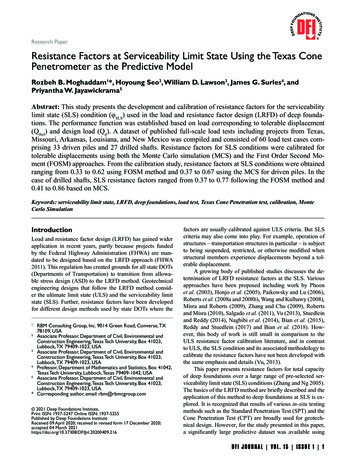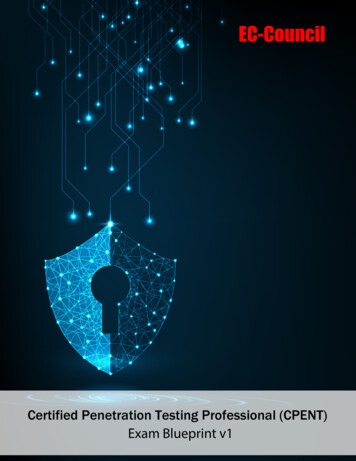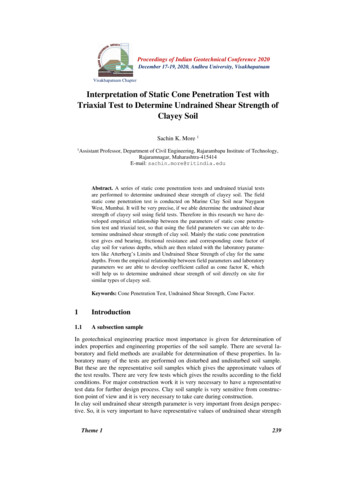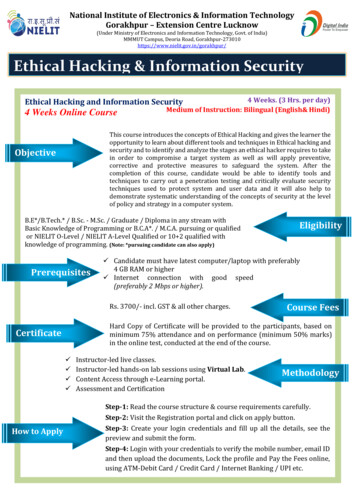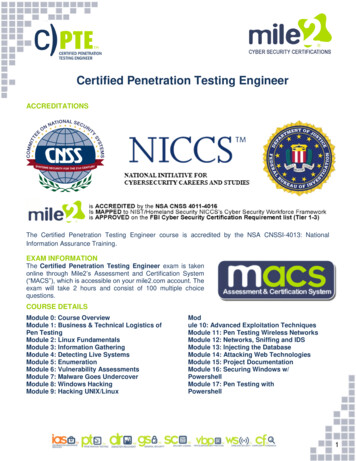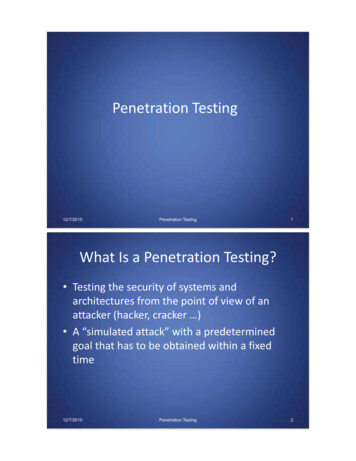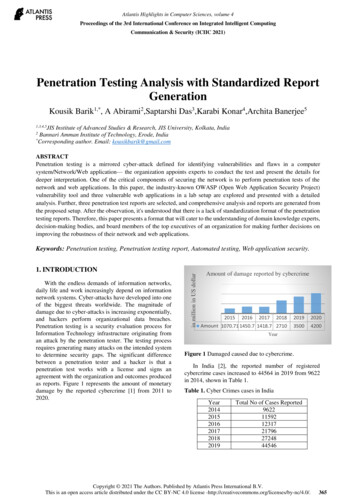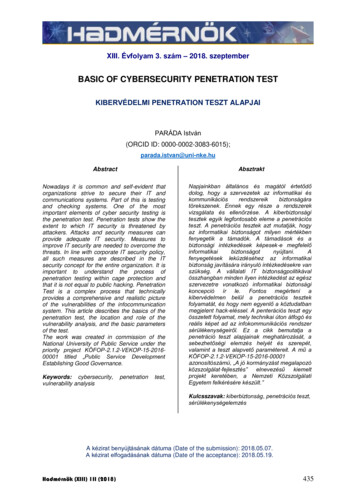
Transcription
XIII. Évfolyam 3. szám – 2018. szeptemberBASIC OF CYBERSECURITY PENETRATION TESTKIBERVÉDELMI PENETRATION TESZT ALAPJAIPARÁDA István(ORCID ID: actAbsztraktNowadays it is common and self-evident thatorganizations strive to secure their IT andcommunications systems. Part of this is testingand checking systems. One of the mostimportant elements of cyber security testing isthe penetration test. Penetration tests show theextent to which IT security is threatened byattackers. Attacks and security measures canprovide adequate IT security. Measures toimprove IT security are needed to overcome thethreats. In line with corporate IT security policy,all such measures are described in the ITsecurity concept for the entire organization. It isimportant to understand the process ofpenetration testing within cage protection andthat it is not equal to public hacking. PenetrationTest is a complex process that technicallyprovides a comprehensive and realistic pictureof the vulnerabilities of the infocommunicationsystem. This article describes the basics of thepenetration test, the location and role of thevulnerability analysis, and the basic parametersof the test.The work was created in commission of theNational University of Public Service under thepriority project KÖFOP-2.1.2-VEKOP-15-201600001 titled „Public Service DevelopmentEstablishing Good Governance.Napjainkban általános és magától értetődődolog, hogy a szervezetek az informatikai zenek. Ennek egy része a rendszerekvizsgálata és ellenőrzése. A kiberbiztonságitesztek egyik legfontosabb eleme a penetrációsteszt. A penetrációs tesztek azt mutatják, hogyaz informatikai biztonságot milyen mértékbenfenyegetik a támadók. A támadások és abiztonsági intézkedések képesek-e getések leküzdéséhez az informatikaibiztonság javítására irányuló intézkedésekre vanszükség. A vállalati IT biztonságpolitikávalösszhangban minden ilyen intézkedést az egészszervezetre vonatkozó informatikai biztonságikoncepció ír le. Fontos megérteni akibervédelmen belül a penetrációs tesztekfolyamatát, és hogy nem egyenlő a köztudatbanmegjelent hack-eléssel. A penterációs teszt egyösszetett folyamat, mely technikai úton átfogó ésreális képet ad az infokommunikációs rendszersérülékenységeiről. Ez a cikk bemutatja apenetráció teszt alapjainak meghatározását, asebezhetőségi elemzés helyét és szerepét,valamint a teszt alapvető paramétereit. A mű �, „A jó kormányzást űkiemeltprojekt keretében, a Nemzeti KözszolgálatiEgyetem felkérésére készült.”Keywords: cybersecurity,vulnerability analysispenetrationtest,Kulcsszavak: kiberbiztonság, penetrációs teszt,sérülékenységelemzésA kézirat benyújtásának dátuma (Date of the submission): 2018.05.07.A kézirat elfogadásának dátuma (Date of the acceptance): 2018.05.19.Hadmérnök (XIII) 1II (2018)435
PARÁDA: Basic of cybersecurity penetration testINTRODUCTIONPenetration testing has been in use for years and there are several methods for testing thetechnical security of the system. However, it is easy to confuse other forms of technicalsecurity testing, especially vulnerability analysis. Many organizations offer security featuresand terms such as security audit, network or risk assessment, and overlapping test overlays orapplication. Security surveys are a risk assessment, that is, services to identify thevulnerability of systems, applications and processes. Penetration testing has been in use foryears and there are many methods to test the technical security of the system. However, it iseasy to coordinate technical security tests in other forms, especially vulnerability analysis.Nowadays there are many free and commercial security scanners, most of which containupdated databases due to known hardware and software failures. These tools are suitable toidentify the vulnerability of the systems under investigation and therefore determine the risksassociated with them. Typically, information provided by such devices includes a technicaldescription of security vulnerability and provides instructions on how to eliminate weakpoints or points by changing configuration settings or updating system components. [1]PENETRATION TEST KEY CONCEPTSDefinition of penetration testPenetration testing uses several manual and automated techniques to simulate anorganization's security information systems attack. This must be done by a qualified andindependent penetration testing expert, sometimes referred to as an ethical security tester.Penetration testing takes advantage of known vulnerabilities, but it also needs testingexpertise to identify specific weaknesses in the organization's security systems - unknownvulnerabilities. [2] The penetration testing process is an active analysis of the target systemdue to possible vulnerabilities that result from incorrect or incorrect system configuration,known and unknown hardware or software failures, and operational weaknesses in process ortechnical countermeasures. This analysis is typically carried out in the perspective of apotential attacker and could include the exploitation of vulnerabilities. So, the penetration testis a way to simulate methods an attacker can use to take over security management of oursystem or access it to a higher level of access. The process itself involves filtering andcollecting vulnerabilities and security risk factors, then exposing them to attack by exploitingthem. The penetration test more than, test runs over scanners or automated tools and thenwrites a report about it. The penetration test evaluates whether the vulnerability is real orfalse. For example, an audit or a survey may use scanning tools that result in hundreds ofpossible vulnerabilities on multiple systems. The penetration test attempts to attack thesevulnerabilities in the same way as a malicious hacker to check which vulnerabilities are real,reducing the realistic list of system vulnerabilities for some security deficiencies. The mosteffective penetration tests are those that target a very specific system that has a very specificpurpose. [3]Penetration testing, often abbreviated as pentest, is a process that is performed to thoroughsafety assessment or audit. The methodology defines rules, practices, and procedures followedand implemented by the information security audit program. The penetration testingmethodology defines a timetable, that provides practical ideas and best practices that can betracked when assessing the true security situation of a network, application, system, or anycombination thereof. Penetration testing can be performed individually or as part of an ITsecurity risk management process that can be integrated into the regular developmentlifecycle. It is essential to note that product safety is not only dependent on factors related tothe IT environment but also relies on product-specific security practices. This includes theHadmérnök (XIII) II1 (2018)436
PARÁDA: Basic of cybersecurity penetration testimplementation of appropriate security requirements, risk analysis, code surveys, andoperational safety measurements. The penetration test is the last and most aggressive form ofsecurity assessment. They must be trained by qualified professionals and can be performedwith or without prior knowledge of the targeted network or application. The penetrationtesting output usually consists of a report that is divided into several parts that address theweaknesses found in the current state of the target environment and then recommend potentialcountermeasures and other recovery suggestions. The use of the methodological approach hasextensive benefits for the tester to understand and critically analyze the integrity of the currentdefense throughout each stage of the testing process. The reason behind the penetrationtesting methodology is the fact that most attackers follow a common approach, when theyenter the system. In the penetration test, the tester is limited by resources: time, skilledresources and access to equipment as outlined in the penetration testing agreement. Thepenetration test simulates the methods used by the intruder that give unauthorized access tothe organization's network and compromise them. This includes the use of own and opensource tools. In addition to automated techniques, intrusion tests include manual techniquesfor testing targeted systems and ensuring that there is no security vulnerability that has notbeen detected before. [4]Vulnerability scannersVulnerability Analysis (also known as "Scanning") is the use of automated tools to identifywell known security vulnerabilities in the system. Vulnerability assessment tools investigateinformation systems to determine whether security settings are turned on and applied, and thatappropriate security patches have been applied. The vulnerability test is typically used tovalidate the minimum level of security - and is often the forerunner of a more specializedpenetration test. It does not use the identification of attacks to re-engage the real attack anddoes not consider the general security of system-based management processes andprocedures. This is the process of scanning network devices, operating systems, andapplications to identify known and unknown vulnerabilities. Vulnerability is a gap, error, orweakness in system design, use, and protection. If a vulnerability is exploited, it may result inunauthorized access, prerogative, denial of service on the device, or other results.Vulnerability surveys typically break when a vulnerability has been found, so the tester doesnot perform an attack on the vulnerability to make sure it is real. The vulnerability assessmentresults with potential recovery steps as well as possible risks associated with anyvulnerability. There are a number of solutions, such as Kali Linux, which can investigatevulnerabilities based on system / server type, operating system, open ports, and otherdevices(for exaple OpenVAS1, MBSA2 Secunia PSI3, Nipper4, Retina5, Nexpose6 GFI LanGuard7.)[5]1The Open Vulnerability Assessment System (OpenVAS) is a framework of several services and tools offering acomprehensive and powerful vulnerability scanning and vulnerability management solution. The actual securityscanner is accompanied with a daily updated feed of Network Vulnerability Tests (NVTs), over 33,000 in total(as of December 2013). All OpenVAS products are Free Software. Most components are licensed under theGNU General Public License (GNU GPL). The OpenVAS is available for FREE and for Linux, Windows andother operating systems.2The Microsoft Baseline Security Analyzer provides a streamlined method to identify missing security updatesand common security misconfigurations. MBSA 2.3 release adds support for Windows 8.1, Windows 8,Windows Server 2012 R2, and Windows Server 2012. Windows 2000 will no longer be supported with thisrelease. MBSA is a FREEWARE and is available only for Windows operating system.Hadmérnök (XIII) II1 (2018)437
PARÁDA: Basic of cybersecurity penetration testVulnerabilities are only useful when calculating the risk. The disadvantage of manysecurity audits is the result of vulnerability testing, which makes security checks longer,without providing real value. Many vulnerable scanners show false results or identifyvulnerabilities that do not really exist. This is because they are incorrectly identifying theoperating system or looking for special fixes to fix vulnerabilities, but they do not investigateinterchangeable fixes (multiple minor fixes) or software modifications. This means that thevulnerabilities reported by the automatic devices must be checked. Vulnerability Assessmentis a process that can measure internal and external security audits by identifying threats thatseverely affect your organization's assets. Internal vulnerability assessment providesassurance of internal systems while external vulnerability assessment demonstrates borderprotection. In both test criteria, all elements of the network are strictly tested against multipleattack vectors to identify unattended threats and quantify reactive actions. Depending on thetype of assessment to be performed, unique testing processes, tools and techniques are used toautomatically detect and identify the vulnerability of information assets. This is achievedthrough an integrated vulnerability management platform that provides up-to-date securityvulnerabilities and can test various types of network devices while retaining the integrity ofconfiguration and change management. [6]Penetration test vs vulnerability analysisThe key difference between vulnerability and penetration testing is that penetration tests gobeyond the level of vulnerability identification that leads to exploitation process, increasingentitlements, and maintaining access to target systems. On the other hand, evaluation ofvulnerability provides a broad picture of system errors, without considering the impact ofthese errors on the system being tested. The other two significant differences between the twoterms are that the penetration test is much more rough than evaluating vulnerability andaggressively uses all the technical methods to take advantage of the IT environment. Thevulnerability assessment process, however, carefully identifies and quantifies all knownvulnerabilities in a non-invasive manner.3The Secunia Personal Software Inspector (PSI) is a free security tool designed to detect vulnerable and outdated programs and plug-ins, which expose your PC to attacks. Once installed, the Secunia PSI can help youpatch vulnerable programs and stay secure. Secunia PSI is available for free and works only with Windowsoperating system.4Nipper (short for Network Infrastructure Parser, previously known as Cisco Parse) audits the security ofnetwork devices such as switches, routers, and firewalls. It works by parsing and analyzing device configurationfile which the Nipper user must supply. This was an open source tool until its developer (Titania) released acommercial version and tried to hide their old GPL releases (including the GPLv2 version 0.10 source tarball).Nipper is available for Windows, Apple MAC OSX, Linux and is a PAID software.5With over 10,000 deployments since 1998, Beyond Trust Retina Network Security Scanner is the mostsophisticated vulnerability assessment solution on the market. Available as a standalone application or as part ofthe Retina CS unified vulnerability management platform. Retina Security Scanner enables you to efficientlyidentify IT exposures and prioritize remediation enterprise-wide.6Nexpose, the vulnerability management software, proactively scans your environment for mis-configurations,vulnerabilities, and malware and provides guidance for mitigating risks. Experience the power of Nexposevulnerability management solutions by knowing the security risk of your entire IT environment includingnetworks, operating systems, web applications, databases, and virtualization.7GFI LanGuard scans and detects network vulnerabilities before they are exposed, reducing the time required topatch machines on your network. GFI LanGuard patches Microsoft , Mac OS X , Linux and more than 50third-party operating systems and applications, and deploys both security and non-security patches. GFI LanGuard is a paid software and only works on Windows operating.Hadmérnök (XIII) II1 (2018)438
PARÁDA: Basic of cybersecurity penetration test1. Figure Penetration test versus vulnerability analysisSo by scanning the vulnerability you will find individual vulnerabilities; penetrationtesting, however, tries to verify whether these vulnerabilities can be exploited in the targetenvironment. Penetration testing in the area of security assessments goes one step beyond thevulnerability tests. Vulnerability Testing - a process that examines the security of individualcomputers, network devices, or applications - the penetration test evaluates the security modelfor the entire network. Penetration testing reveals the potential consequences for networkadministrators, IT managers, and executives for a real attack on the network. Penetration testshighlight the typical safety deficiencies that have been omitted during the vulnerability test.The penetration test points out the vulnerabilities and documents that these weaknesses can beexploited. It also shows that an attacker can exploit a number of minor vulnerabilities thatcompromise computers or the network. Penetration testing highlights the lack oforganizational security modeling and helps organizations strike a balance between technicalperformance and business functions for potential security injuries. This information is alsouseful for disaster recovery and business continuity planning.[7]Most vulnerabilities are evaluated only by software and do not evaluate other types ofpotential security issues. Human factors and processes can be important sources ofvulnerabilities, just as technology or software vulnerabilities. By using social engineeringtechniques, intrusion tests may reveal whether employees can routinely allow people to enterinto enterprise facilities without unauthorized access and unauthorized access to a computersystem. Exercises applied during the patch management cycle can be evaluated during thepenetration test. The penetration test is an ethical attack simulation designed to demonstrate orenforce the effectiveness of security controls in a given environment through exploitablevulnerabilities that pose real risks. It is built around a manual testing process that aims tomove on through general responses, false positive results, and incomplete automated appratings (such as tools used in vulnerability assessments). [8]Hadmérnök (XIII) II1 (2018)439
PARÁDA: Basic of cybersecurity penetration testMAIN PARAMETERSObjectivesIn the case of a successful penetration test for the customer's expectations, a cleardefinition of the goals is indispensable. If the goals can not be achieved or are not effectivelyachieved, the tester should inform the customer during the preparatory phase and recommendalternate procedures. The result of the IT penetration test should therefore be more than just alist of existing vulnerabilities; Ideally, it should also provide concrete solutions andsuggestions.Intrusion testing is performed by an organization to achieve the following goals: Improving the safety of technical systems Identify vulnerabilities Confirming IT security by an external third party Improving the security of organizational and personnel infrastructure Test and confirm the safety and control efficiency Ensure availability of the organization's internal and external vulnerabilities Provide useful information to audit teams that collect data to comply withlegislation Minimizing the costs of security controls by providing comprehensive and detailed,realistic evidence of business capability Promote the relevance of relevant patches for reported or known vulnerabilities Disclosing the existing risks of the organization's networks and systems Evaluating the effectiveness of network security tools, such as firewalls, routers,and web servers Develop a comprehensive approach to prepare for preventing future exploitation Find out if any existing software, hardware or network infrastructure needs to bemodified or upgradedMost penetration tests are commissioned to improve the safety of technical systems. Testsare limited to technical systems such as firewalls, routers, web servers, etc. The organizationaland personnel infrastructure is generally not specifically tested. The penetration test can alsobe performed for confirmation from an independent external third party. It is important to notethat the penetration test reflects the situation only at a certain point in time and can not,therefore, give a statement about the future security level. [9]What makes a good penetration test?The following activities ensure good penetration: Define the parameters of the penetration test, such as goals, limitations, andjustification for the procedures Recruit highly trained and experienced professionals Appoint a legal penetration tester who follows the rules in the terminationagreement Select a suitable test package that balances costs and benefits Follow up a well-designed methodology with documentation and documentationthat documents the results carefully and makes them understandable to thecustomer. An intruder tester should be available to answer any questions whenneeded. The final report provides a clear description of the findings and recommendationsHadmérnök (XIII) II1 (2018)440
PARÁDA: Basic of cybersecurity penetration testLimitsPerforming penetration test runs will help you examine some of your security measures andimprove your development, but there are limitations. For example, a penetration test: It covers only the targeted application, infrastructure, or the selected environment Focuses on the discovery of technical infrastructure, It covers only a small part of the human resources screening, specifically (socialenginnering) Just snapshot from a system at a given time By legal or commercial considerations, the width or depth of the test can be limited You cannot detect all security weaknesses, for example due to limited scope orinappropriate testing Provides results that are often of a technical nature and need to be interpreted in abusiness contextChallengesIn general, organizations have encountered the following difficulties:Determining the depth and width of the test coverage Determine what type of penetration test is required Understand the difference between vulnerability and pentest Identify the risks associated with possible system failures and disclosure of sensitivedata Frequency of goals and tests To improve the vulnerabilities discovered during the penetration test, the system willreally be "safe"The needThe main drivers of penetration testing include a high level of concern about: Increasing compliance requirement The impact of serious (often Internet) security attacks on similar organizations Utilize the number and variety of outsourced services Significant changes in business processes Awareness raising about potential cyber security attacks. [10]CONCLUSIONSThe summary should briefly summarize the conclusions, the results, possible suggestions andother new research orientations. The summary is also a mandatory element of thepublications. The cybersecurity penteration test provides a thorough study of IT systems. As aresult of today's trends, this choice of test methods provides complex analysis that covers thesystem and the organization's IT-related questions. It shows significant differences in testingvulnerabilities but provides a more comprehensive approach from the attacker's point of view.With this test, the identified safety deficiencies are not only collected but also exploited. theattacker goes on to exploit the vulnerability analysis as it may go further, get new information,and do more attacks. Then a comprehensive report is prepared, including suggestions.Penetration Test is one of the most important technical tests of cyber security to ensure systemsecurity. Considering a number of international standards, however, there are manydefinitions and rounding differences. Standards are, of course, a major direction, but there area lot of differences. This is because, on the one hand, these are recommendations, are notHadmérnök (XIII) II1 (2018)441
PARÁDA: Basic of cybersecurity penetration testbinding. On the other hand, the penetration test itself depends on the attacking nature andexpertise, so it can be said to try the objective test, but there are subjective elements in it. Thatis why I thought it important to define basic definitions, goals and features. This publicationhas collected the basic understanding of the penetration test, the differences between thefragility test and the penetration test. This includes the benefits, goals, and limitationsassociated with the test.BIBLIOGRAPHY[1]FEDERAL OFFICE FOR INFORMATION SECURITY (BSI) STUDY: A PenetrationTesting Model; Bonn p.8.[2]JASON C, IAN G.: A guide for running an effective Penetration Testing programmeApril (2017) p.8.[3]GEORGIA W.: Penetration testing A Hands-On Introduction to Hacking; SanFrancisco ISBN-10: 1-59327-564-1 ISBN-13: 978-1-59327-564-8 (2014) pp.31-36.[4]LEE A, TEDI H, SHAKEEL A.: Kali Linux – Assuring Security by Penetration Testing,Birmingham ISBN 978-1-84951-948-9; (2014) pp. 51-52.[5]EC-COUNCIL CERTIFI ED SECURITY ANALYST PRESS: Penetration TestingProcedures and Methodologies ISBN-13: 978-1-4354-8367-5 ISBN-10: 1-4354-8367-7,USA (2011) p.23.[6]JOSEPH M, AAMIR L.: - Web Penetration Testing with Kali Linux; Birmingham.ISBN 978-1-78216-316-9 (2013) p.13.[7]LEE A, TEDI H, SHAKEEL A.: Kali Linux – Assuring Security by Penetration Testing,Birmingham ISBN 978-1-84951-948-9; (2014) pp. 53-54.[8]JASON C, IAN G.: A guide for running an effective Penetration Testing programmeApril (2017) p.9.[9]EC-COUNCIL CERTIFI ED SECURITY ANALYST PRESS: Penetration TestingProcedures and Methodologies ISBN-13: 978-1-4354-8367-5 ISBN-10: 1-4354-8367-7,USA (2011) p.24.[10] JASON C, IAN G.: A guide for running an effective Penetration Testing programmeApril (2017) pp.10-12.Hadmérnök (XIII) II1 (2018)442
1 The Open Vulnerability Assessment System (OpenVAS) is a framework of several services and tools offering a comprehensive and powerful vulnerability scanning and vulnerability management solution. The actual security scanner is accompanied with a daily updated feed of Network Vulnerability Tests (NVTs), over 33,000 in total (as of December 2013).

